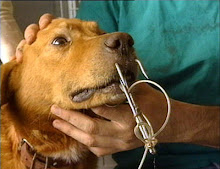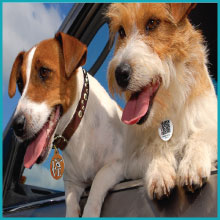Consumer Reports: Pricey Pet Food Not Necessarily Better
Consumer Reports advises consumers about what to look for on pet-food labels; plus, fancy claims consumers can ignore
YONKERS, N.Y., Feb. 2 /PRNewswire/ -- When it comes to buying pet food, higher cost doesn't always mean higher quality, according to the March issue of Consumer Reports. A higher price could indicate better ingredients and better quality control during and after manufacturing, but it could also just mean prettier packaging, more marketing, or a fancy name. And despite food safety concerns that resulted from a recall of pet food tainted with melamine in 2007, Consumer Reports urges caution for consumers who are considering making their own pet food, a growing trend.
The full report is available in the March 2009 issue of Consumer Reports and online at www.ConsumerReportsHealth.org.
Consumer Reports asked eight experts in dog and cat nutrition at seven top veterinary schools what consumers get by spending more for pet food. They were also asked what they served their own pets: Most of the experts said they use a variety of common brands sold at pet stores or supermarkets.
A recent survey by the Associated Press found that although Americans may be spending less on themselves, they're not scrimping on their pets. According to the survey, just one in seven pet owners said they had curtailed spending on their pet during the past year, even as they cut back on other expenses.
Thirty-seven percent of U.S. households have dogs, and 32 percent have cats. But because of multi-cat households, felines outnumber canines: As of 2007, there were almost 82 million cats and 72 million dogs.
The bottom line, says Consumer Reports: It's more important to look for the overall nutrient profile of a particular pet food brand than it is to shop by price or even individual ingredients. "As a pet owner, your main goal is to ensure that your animal is active and healthy," says Jamie Hirsh, associate health editor at Consumer Reports. "That suggests that the food you're buying is doing its job. But it's also important to know that you don't have to choose the most expensive food to get what's best for your pet. Look for food labeled 'complete and balanced,' which indicates it can be the pet's sole nourishment."
Hirsh advises pet owners to look for labels stating that the food's nutritional adequacy was validated by animal-feeding tests based on protocols from the American Association of Feed Control Officials, a regulatory group. That statement is a step above the other one that AAFCO allows -- that a food was formulated to meet the group's nutrient profiles. "In addition, make sure the package has contact information for the food's manufacturer, in case you have questions," Hirsh says.
Consumers should also take into consideration the age of their pet and whether he or she has special needs. For example, cats with kidney or urinary problems might benefit from the moisture in wet food, while animals with dental issues might do better with dry food.
What Pet-Food Labels Really Mean
For pet food, there's no official definition of organic, human-grade, premium, no fillers, or gourmet. Gluten-free foods are generally necessary only for the tiny percentages of pets that are intolerant of that protein. There's some evidence that antioxidants -- such as vitamin E -- and some omega-3 fatty acids might enhance pets' immunity or help protect against certain diseases, but the experts interviewed by Consumer Reports were split on whether consumers need to look for them.
Consumer Reports recommends that consumers educate themselves about pet food labeling, which is mostly defined by AAFCO, which sets standards for pet food manufacturing. Here are some examples:
The 95 percent rule (Beef for Dogs). Named ingredient(s) must account for a least 95 percent of the product by weight.
Dinner; also Entree, Formula, Nuggets, Platter, Recipe (Chicken and Salmon Dinner for Cats). The named ingredients must make up at least 25 percent of the product by weight, not counting water. Each individual food must make up at least 3 percent.
"With ..." (Gourmet Fillets with Turkey for Dogs). Contains 3 percent or more of the named ingredient.
Flavor (Beef flavor). No specific percentage required, but the product must contain enough of the food to impart the claimed flavor, or another substance that tastes like it (beef stock, for example).
Guaranteed analysis. Mandatory guarantee that the food contains the labeled percentages of crude protein, fat, fiber, and moisture.
Light, lite, low-calorie. Meets AAFCO limits for a reduced-calorie diet for overweight dogs and cats. "Lean" and "low-fat" have a similar meaning for fat.
Natural. Technically, the food has few or no synthetic ingredients. But the claim is loosely defined.
Grain-free. Protein in the product comes from nongrain sources (perhaps for people who want pets to eat more animal protein). It's unclear whether there's any benefit to a diet high in animal protein.
What Consumers Can Do
Consumer Reports offers the following advice to pet owners:
Be careful when making your own pet food. Most experts said they hadn't seen a pet get sick from inexpensive food; however, half said they had seen pets become ill from eating homemade pet food, a growing trend since the 2007 recall of some commercial pet food contaminated by melamine. Dogs and cats each require about 40 different nutrients in very specific proportions, so pet owners who insist on making their own pet food should consider enlisting a nutritionist certified by the American College of Veterinary Nutrition (www.acvn.org) or get help from the Web sites www.balanceit.com or www.petdiets.com.
Consider your pet's age. Age-specific food is very important for puppies, kittens, and pregnant pets, who have especially stringent nutritional needs. Foods labeled either "for growth" or "for all life stages" meet those needs. Foods "for maintenance" are for healthy adult animals only. "Senior" is a marketing term, not a nutritional term.
Weigh the costs and benefits of wet versus dry food. There's no nutritional difference between wet and dry pet food, but there is a cost difference. Wet foods contain about 75 percent water, so pets need more to get the same calories, and that makes wet food more expensive per serving.
Monday, February 2, 2009
Subscribe to:
Post Comments (Atom)

















1 comment:
From raw meat and bone diets, large portions of grains to fruit and even supplements one viewpoint supported by most dog lovers seems to encourage the feeding of a good quantity of meat. No matter what other foods you choose to give your dog, meat and meat products will always form an important part of a healthy diet for your dog. Unlike us, dogs are carnivores and need meat protein in their diets. Meat is the most important part of a healthy diet for your dog.
Pet Feeding Myths
Dogs Health
Post a Comment